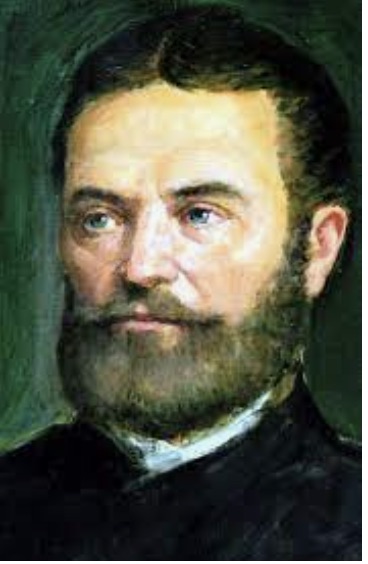
János Bolyai was born on December 15, 1802, in the Austrian Empire (present-day Romania). He was the son of another eminent mathematician, Farkas Bolyai, who stimulated his son’s interest in mathematics. Under the tutelage of his father, János mastered calculus and mechanics by the age of 13. Between 1818 and 1822, he studied at the Imperial and Royal Military Academy in Vienna. By age 24 he had reached the rank of captain after passing through the ranks of lieutenant and first lieutenant.
Though many mathematicians had attempted and failed to deduce Euclid’s Fifth Postulate from the first four postulates, the Fifth Postulate appeared to be intuitively obvious, because our experiences up to the mid-19th century were restricted to short distances. However, János, instead of attempting to derive the Fifth Postulate from the other four, explored whether a geometry could exist in which the first four Euclidean postulates were true, along with a fifth postulate that contradicted Euclid’s Fifth. He became so obsessed with this possiblilty that his father, who had attempted a similar feat years earlier wrote to him in 1820, advising, “You must not attempt this approach to parallels. I know this way to the very end. I have traversed this bottomless night, which extinguished all light and joy in my life. I entreat you, leave the science of parallels alone…Learn from my example.”
In spite of his father’s admonition, János published in 1832 his groundbreaking work Tentamen in which he developed a complete and consistent system of hyperbolic geometry, using a fifth postulate that contradicted Euclid’s Fifth Postulate. (The Fifth Postulate asserts: given a line and a point not on the line, a unique line can be drawn through the point parallel to the given line. ) Unfortunately, the significance of Bolyai’s achievements, owing to their radical departure from the accepted postulates of Euclidean geometry, were unrecognized, prompting Bolyai to become disillusioned with the mathematical community. Although this work gained prominence after the discoveries by other mathematicians like Nikolai Lobachevsky, who independently reached similar conclusions, this recognition did not come during Bolyai’s lifetime.
In spite of its protracted emergence into the mathematical conscious, Bolyai’s work laid the groundwork for later mathematicians, particularly Bernhard Riemann and others, to further develop and formalize non-Euclidean geometry. This new unfamiliar geometry was to play a crucial role in the revolution of mathematics and physics in the 19th and 20th centuries, particularly in Einstein’s General Theory of Relativity.
By challenging the parallel postulate in Euclidean geometry, János Bolyai discovered an absolute geometry that contained both the hyperbolic and Euclidean geometries, paving the way for different models of the universe. Expressing the inevitability of an idea whose time has come, he stated, “Mathematical discoveries, like springtime violets in the woods, have their season which no human can hasten or retard.“
János Bolyai died of pneumonia in 1860 at the age of 57, leaving behind more than 20,000 pages of unpublished manuscript. When Carl Friedrich Gauss read Bolyai’s Tentamen, he declared, “I regard this young geometer Bolyai as a genius of the first order.”
